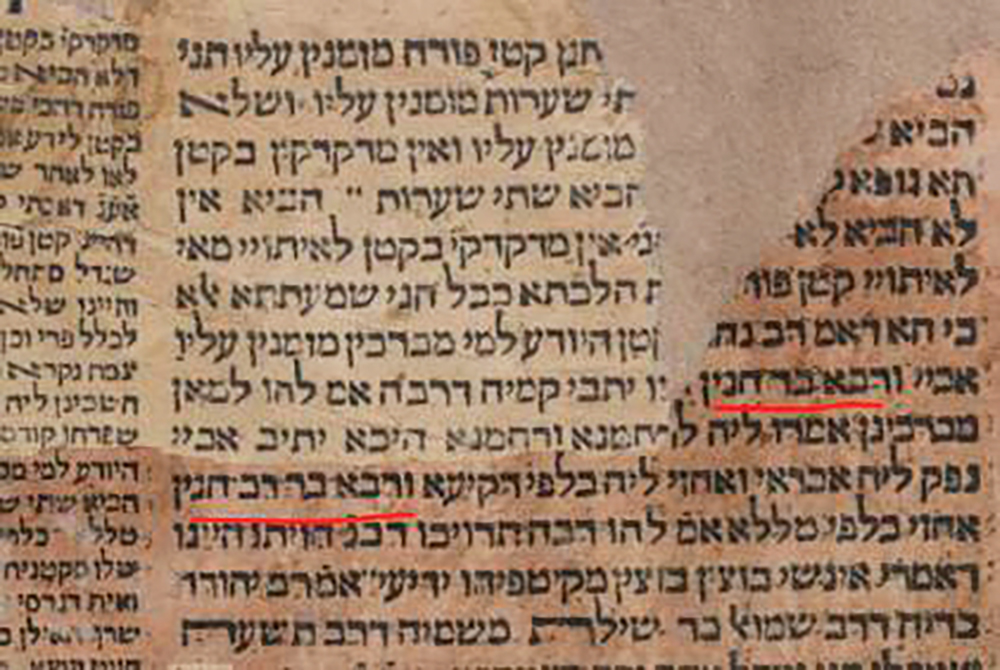
On Bava Batra 26a, in Pumbedita, Rava bar Rav Chanan had date palms which adjoined Rav Yosef’s vineyard. Birds would roost on the palm trees and descend to the vineyard, damaging it—presumably by eating the grapes. Rav Yosef told him to cut down his palm trees. Rava bar Rav Chanan replied: “But I distanced the required amount!” Rav Yosef replied that that measure is between trees and trees, or vines and vines—not between trees and vines. Rava bar Rav Chanan replied that he didn’t want to incur divine wrath by cutting down fruit trees, but that Rav Yosef was free to cut them down himself.
There’s a generation disparity between Rav Yosef and Rava bar Rav Chanan. Recall the famous story, in Brachot 48a, where fourth-generation Abaye and Rava—both minors—sat before Abaye’s third-generation uncle, Rabba (bar Nachmani). Rabba wished to have a mezuman (a group of at least three adult males), and set out to determine if these minors were aware enough to count. He asked them, “To whom does one recite brachot?” They replied, “To the All-Merciful … ” Rabba asked, “And where does the All-Merciful reside?” Rava pointed upwards, and since they were inside, towards the ceiling. Abaye always has to argue, so he went outside and pointed towards heaven. Rabba told them, “You will both become Sages … ”
While this story resonates best as a dispute between Abaye and Rava, it’s most likely that Abaye’s childhood friend is the native Pumbeditan, Rava bar Rav Chanan. After all, Rava spent his youth in Mechoza, not Pumbedita. The Faro printing and several manuscripts (Florence 7, Munich 95, Rab. 26, CUL: T-S F 1(1).106 and 113) have Rava bar Rav Chanan, or slight variations thereof. The principle of “lectio difficilior” pertains here, as scribes would refer to Rava—the more famous disputant of Abaye—but what scribe would twice insert this barely known Amora.
Rabba and Rav Yosef are third-generation contemporaries, and Abaye and Rava bar Rav Chanan are fourth-generation Amoraim. Thus, there is a knowledge and power disparity between Rav Yosef and Rava bar Rav Chanan, which may explain why the latter accepts the former’s interpretation.
How Many Cubits?
Rava bar Rav Chanan thought he distanced his date palms the “required amount.” What distance is this? The preceding mishna had given this measure of four cubits, to distance a field from a tree or vine. However, in the ensuing Gemara, Shmuel said that they taught this halacha regarding the land of Israel, where the mishna was authored. In Bavel, however, only two cubits are needed. (Rashi: “Because the plows are shorter.”) So too, the Gemara notes, a baraita describes the mishna’s case, but with two cubits distance, which can be understood as describing Babylonian practice.
There were Tannaim in Bavel, and it seems plausible that this is a Babylonian baraita. Indeed, throughout these sugyot, there are baraitot with divergent measures from the mishna, or baraitot from each other. For instance, Bava Batra 11a about four versus eight cubits square for a courtyard division, or Bava Batra 19a about three handbreadths versus four cubits for a launderer’s pond. There’s Bava Batra 12a, with the Tanna Kamma and Rabbi Yehuda arguing about whether it’s nine kav for a field division, or half that. The Gemara explains that there’s no real dispute, but each follows the custom of their place (in the land of Israel). Regarding Bavel, Rav Yosef explains it is the amount one can plow in a day. (We might understand this as the reason for the Tanna Kamma/Rabbi Yehuda dispute—based on different soil quality—but perhaps not.)
While we can explain these as disagreeing Tannaim, discussion of different cases, or the same principle applied to different local realities. However, another possibility is that these are regulations by fiat, and local Sages in different places in Israel and Bavel made different arbitrary estimations of how much space was needed. As the mishna says repeatedly, הַכֹּל כְּמִנְהַג הַמְּדִינָה, or as Rabbi Yossi says in a baraita, אֵין אֵלּוּ אֶלָּא דִּבְרֵי נְבִיאוּת.
By analogy, during Covid, the CDC (Centers for Disease Control and Prevention) instructed Americans to distance six feet apart, using imperial measurements. In Europe, where they employ metric units, many countries followed the WHO (World Health Organization)’s one meter (about 3.28 feet) rule. As Dr. Anthony Fauci later mentioned, the six-feet guidance “sort of just appeared.” It wasn’t the result of controlled studies of Covid’s spread, but an arbitrary assessment by different scientists of what was reasonable. This divergence had real repercussions—for instance, remote schooling was partly prompted by the six foot rule, since there wasn’t enough room in classrooms at full capacity to distance that much.
Rav Yosef’s Measure
Despite Shmuel’s change of four cubits to two cubits, Rashi explains that the typical “required amount” understood by the Pumbeditan Amoraim, Rav Yosef and Rava bar Rav Chanan, was four cubits. This seems strange, but Tosafot points us to Bava Batra 82b, where Rav Yosef assumes four cubits; thus, sometimes even in Bavel a field required a longer plow.
Let’s explore that sugya in greater detail: There are divergent traditions in Shmuel. Rav Yosef quotes his Pumbeditan teacher Rav Yehuda who quotes Shmuel that a grouping of three trees—to be considered a single unit—is between four and eight cubits. Rava quotes his Nehadean teacher Rav Nachman who quotes Shmuel, that it’s between eight and sixteen cubits. Rav Yosef’s student, Abaye, takes up Rav Nachman’s cause, and Rav Yosef defends.
Rav Yosef says: “I don’t know about your proof, but there was a case (involving a sale of trees) in a village of shepherds which came before Rav Yehuda, who said ‘give the buyer כִּמְלֹא בָּקָר וְכֵלָיו, sufficient land for an ox and its vessels.’ I didn’t know how much כִּמְלֹא בָּקָר וְכֵלָיו was, until I concluded based on the mishna (in our sugya, Bava Batra 26a) that a person may not plant his tree close to another’s field unless he distances four cubits. Thus, we see Rav Yosef adopt the four cubit rule and apply it to a case before Rav Yehuda, which presumably happened in Bavel. The “ox’s vessels” are the plow, so this must be the longer plow.”
I wonder if we must assume that Rav Yosef has perfect knowledge, so the fields and plow lengths vary in Bavel. Consider that Rav Yosef was blind, so wouldn’t rely on experiential knowledge, to look at the local plows and measure them, instead turning towards his memorized Oral tradition. Also, given that Rav Yosef and Rava have different Shmuel traditions, and Amoraim know mishnayot but not all baraitot, must we assume Rav Yosef received the tradition of a divergent practice in Babylonia about tree distance?
I also wonder at Rav Yehuda’s usage of the cryptic and, indeed, troublesome כִּמְלֹא בָּקָר וְכֵלָיו measure. Is this like Americans avoiding the metric system and measuring asteroids in giraffes? Does an ox plus plow have a specific significance for defining a tree orchard unit, so that one can deal with the trees?
Finally, I wonder if Rav Yehuda means to invoke the mishna with his language of כִּמְלֹא בָּקָר וְכֵלָיו, in which case Babylonian divergent practice is irrelevant, even for Rav Yosef. Alternatively, perhaps Rav Yehuda meant a real world unit. In “Minecraft,” each block is exactly one meter. In the real world, items don’t fit into precise halachic units of cubits, handbreadths and fingers. COVID-19 doesn’t know to stop at precisely 3.28 feet, and enzymes don’t break down meat caught between the teeth in precisely six hours—thus Rambam’s כְּשֵׁשׁ שָׁעוֹת wait between meat and milk. Perhaps Rav Yehuda didn’t intend a four cubit measure, but even fractions of cubits and handbreadths, and in accordance with practical local reality.
Rabbi Dr. Joshua Waxman teaches computer science at Stern College for Women, and his research includes programmatically finding scholars and scholastic relationships in the Babylonian Talmud.










